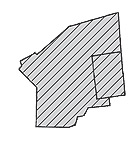|
|
Second Temple Period >> Late Roman Period - Aelia Capitolina 135-326 CE
|

|
From the destruction of the Second Temple in 70 CE until the end of the third century Jerusalem extended across the northern parts of the Old City but was no longer fortified by a wall. The city, which was built and planned from the time of Hadrian, was apparently an open city that was protected by the soldiers of the Tenth Legion. The city was delimited by a wall only at the end of the third or the beginning of the fourth century CE. The line of the new city wall was built on sections of ancient walls and parts of it are identical to the line of the Ottoman wall. There were four gates set in the wall: Damascus Gate in the north, Jaffa Gate in the west, Lions Gate in the east and the old Zion Gate in the south. The line of fortifications was identified in the north and west of the city.
A presumed restoration of the line of the southern wall has been proposed. The victory gate in the Roman gate complex in the vicinity of Damascus Gate is incorporated in the northern wall. The part of the northern wall from the Lions Gate until the region of the Rockefeller Museum was rehabilitated. There is no consensus regarding the route of the western wall (east or west of the line of the Ottoman wall). The Third Wall was built in order to defend the city's northern regions and a number of assumed routes have been ascribed to it.
Finds:
Only a few finds were discovered that date to the Roman period; however, the items that were found are especially impressive and include the gate, towers and the paved plaza at Damascus Gate.
Historical Sources:
The paucity of historical sources has hampered research.
Remarks:
The original names of the gates from the Roman period are not known. The northern part of the cardo, probably from Damascus Gate to the vicinity of the markets, dates to the Roman period and the rest of it is ascribed to the Byzantine period.
|
|

|
| The wall in the Late Roman period |
|
 |
 |
|
|
| Websites, text and photos © Israel Antiquities Authority |
Powered by teti-tu |
|
|















